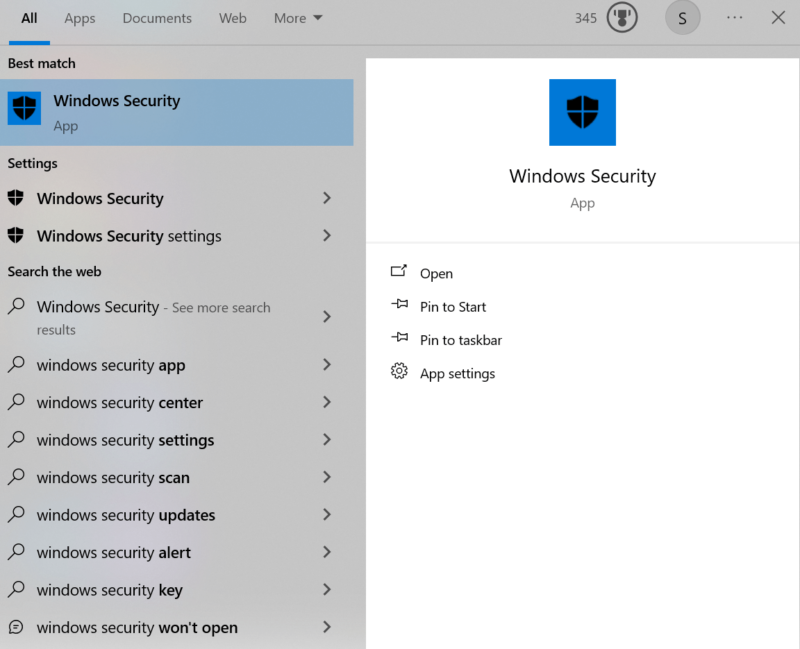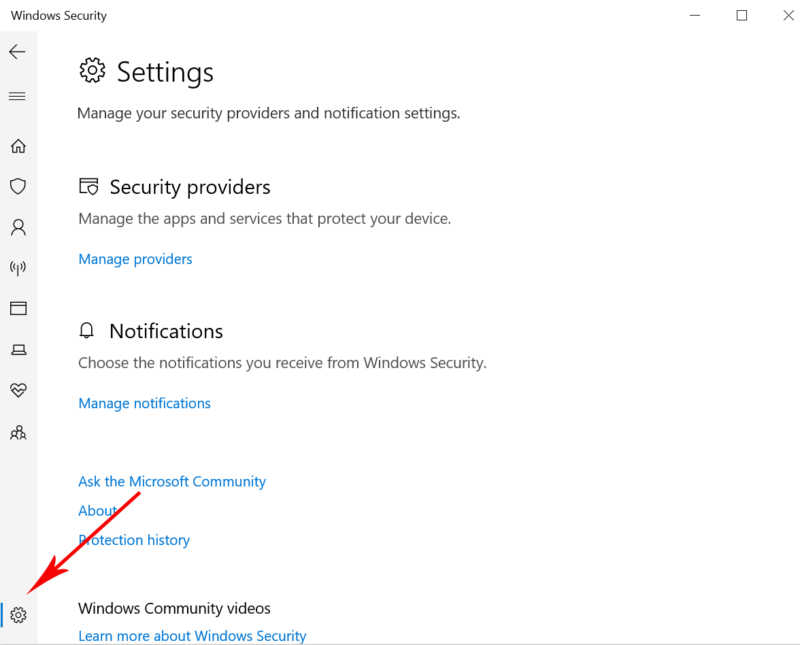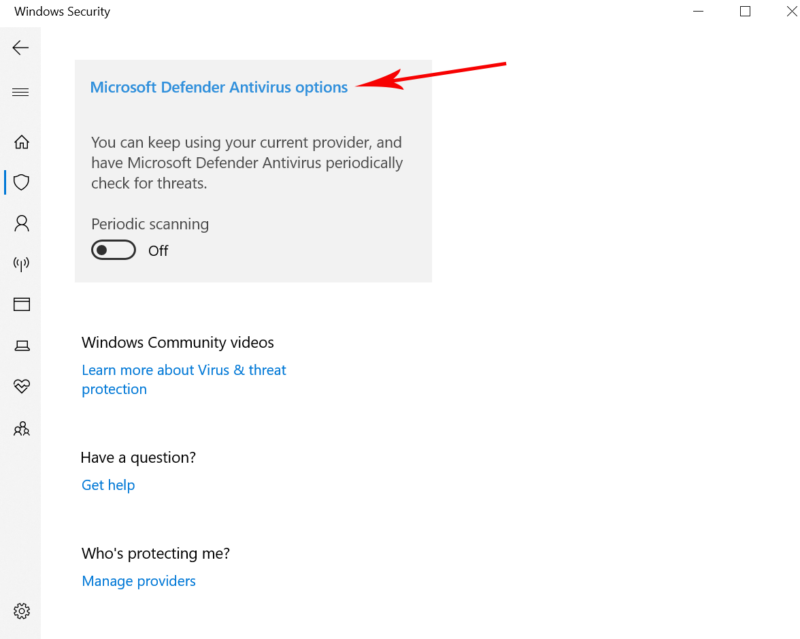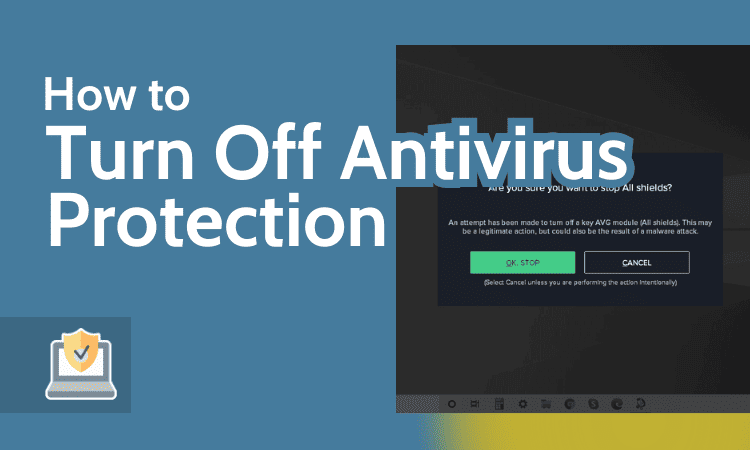
How to Turn off Antivirus Protection: Software & Device 2024 Search
Cloudwards.net may earn a small commission from some purchases made through our site. However, any earnings do not affect how we review services. Learn more about our editorial integrity and research process.
Why you can trust us
- 407 Cloud Software Products and Services Tested
- 3056 Annual Software Speed Tests
- 2400 plus Hours Usability Testing
Our team of experts thoroughly test each service, evaluating it for features, usability, security, value for money and more. Learn more about how we conduct our testing.
Key Takeaways: How to Turn Off Antivirus
- Most antivirus software can be disabled in just a few steps
- Turning off antivirus protection can leave your device vulnerable to threats, so it is wise to turn it back on as soon as possible
- There are a number of different ways to disable antivirus, and we cover many of them here
Sometimes it is necessary to disable antivirus protection in order to install software or troubleshoot issues. If you want to turn off your antivirus permanently or temporarily, you can do it through the antivirus app, your device or your browser. In this guide, we will walk you through several ways to turn off antivirus protection.
There are a lot of antivirus options to choose from. Check out our article on the best antivirus software for help on choosing the best option for you.
Meet the experts
Learn more about our editorial team and our research process.
How to Turn Off Antivirus Protection: Quick Steps
Turning off antivirus protection generally only requires a few steps. In our example, we will use Windows Security. We talk about other providers below.
- Open Windows Security
Search for Windows Security and open the app.

- Navigate to “Settings”
Find the gear icon in the lower-right corner of the Windows Security app and click on it.

- Turn Off Windows Security
Either switch “real-time protection” to off or go to “options” in Microsoft Defender Antivirus and toggle “periodic scanning” to off.

How to Turn Off Antivirus By Software
The process of turning off antivirus software varies depending on the specific application and operating system. This guide will provide steps for many of the major antivirus providers and operating systems.
AVG (Windows)
- Go to the AVG icon in the Windows taskbar and right click on it.
- Find “protection is -” and toggle it from “on” to “off.”
- AVG will ask whether you are sure you want to stop all shields. Click “OK, stop.”
Avast
- Select “settings.”
- Navigate to “protection.”
- Click “core shields.”
- Move the green toggle to the left.
- Choose “disable antivirus” from the drop-down menu.
- Click “OK, stop.”
Avira
- Open the Avira user interface.
- Click “security.”
- Click “protection options.”
- Click the on/off switch under “web protection.”
ESET
- Select “setup” in the panel to the left of the main interface.
- Select “computer protection.”
- Click the “pause antivirus and antispyware protection” tab at the very bottom of the screen.
- Choose the length of time that you would like it to be paused and click “apply.”
McAfee (Windows)
- Click the settings icon.
- Select “real-time scanning” from the menu.
- Click the “turn off” button.
McAfee (Mac)
- Click the settings icon.
- Select “real-time scanning.”
- When prompted, type in your password and click the lock icon.
- Toggle the slider to “off.”
- Click the lock icon again.
Norton (Windows)
- Navigate to “settings.”
- Click “administrative settings” and log in to your administrator account.
- Right-click on the Norton icon.
- Click “disable auto-protect.”
- Choose for how long you want the antivirus to remain disabled.
- Confirm by clicking “OK.”
Norton (Mac)
- Navigate to the window labeled “my Norton” and click “open.”
- Click either “advanced” or “settings” in the main window.
- Go to “protect my Mac” and toggle “automatic scans” to “off.”
- Go to Firewall and toggle “connection blocking” and “vulnerability protection” to “off.”
Webroot
- Right click on the SecureAnywhere icon in your system tray.
- Click “shut down protection” when it appears at the bottom of the drop-down.
- When the prompt asking you to confirm appears, click “yes.”
- You may be asked to complete a CAPTCHA.
Kaspersky
- Go to the menu bar and click the “application” icon.
- Select “turn protection off” from the menu that appears.
Vipre (Windows)
- Right click the Vipre icon in the system tray.
- Select “shut down Vipre.”
Trend Micro (Mac)
- Click the Trend Micro icon in the menu bar.
- Select “shut down Trend Micro Antivirus.”
Bitdefender
- Click the “protection” tab to the left of the main interface.
- Click on “antivirus” and open it.
- Click “advanced” and turn off Bitdefender Shield.
- Choose whether to turn it off permanently or temporarily and click “OK.”
Malwarebytes
- Click on “settings.”
- Go to the “protection” tab.
- Go to “real-time protection” and toggle all four sliders to “off.”
- Click “yes” when prompted.
How to Disable Antivirus Software By Device or System
This process can differ depending on the device or system you are using. This section will walk you through the steps to disable antivirus software across devices and systems so you can safely manage your security settings.
Windows
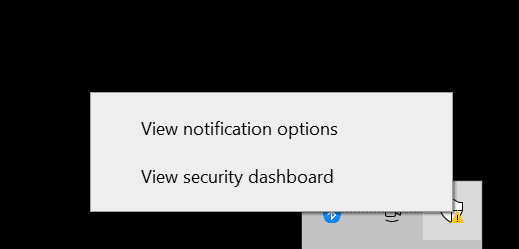
Turning antivirus protection on or off in Windows requires only a few steps.
Removing or pausing antivirus software on Windows is a simple and straightforward process. Windows comes with built-in antivirus software, but if you are looking for something stronger, check out our list of the top five most secure antivirus providers.
- Select the antivirus app you want to pause or discontinue from the system tray.
- Right click on it and select “turn off” or “pause protection.”
- Click “apply” if prompted.
MacOS
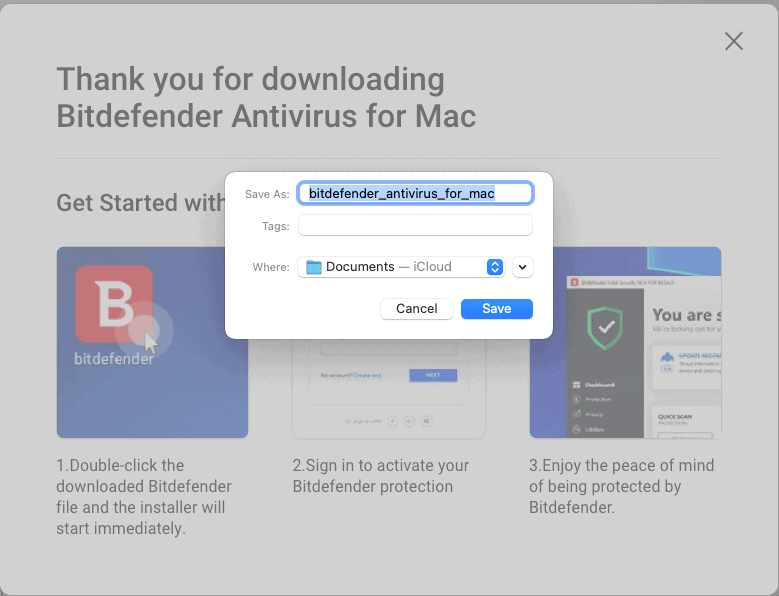
Bitdefender is easy to install on Mac or Windows OS.
Here, we will show you how to force quit your antivirus software on a Mac device in three steps. If you are looking to replace your current antivirus provider, check out our article on the best antivirus for Mac.
- Open your antivirus app and press “option + command + escape.”
- A “force quit applications” window will appear. Select the antivirus app.
- Click “force quit.”
Android
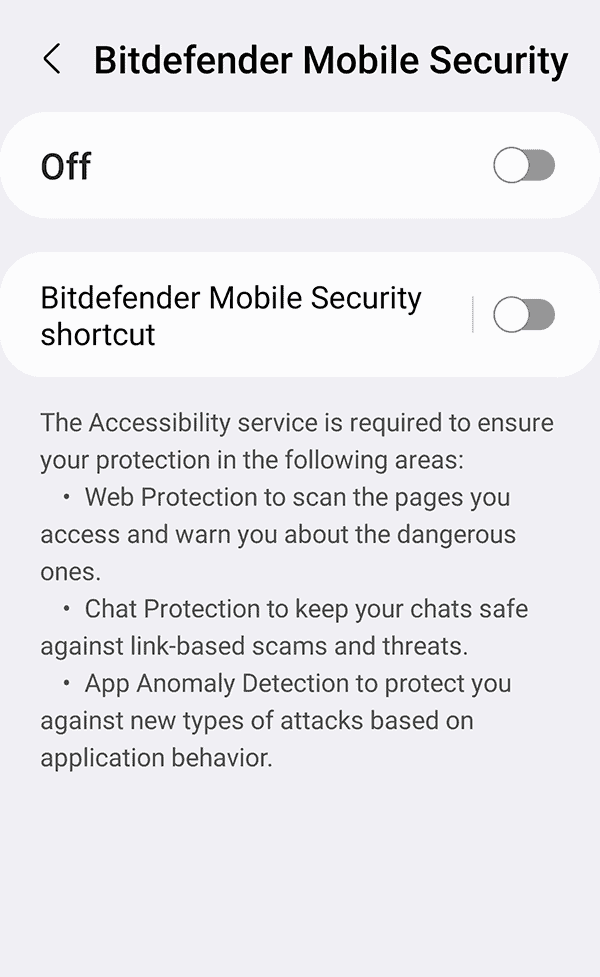
Antivirus products on Android can be uninstalled via “settings.”
Most antivirus software can be uninstalled on Android by dragging it to the trash icon that will appear if you long-press on the antivirus logo on your mobile device. However, but if you need to force uninstall, follow these steps:
- Open your device settings and go to “Apps.”
- Find the antivirus app for the software you use and tap on it.
- Follow the on-screen instructions.
iPhone
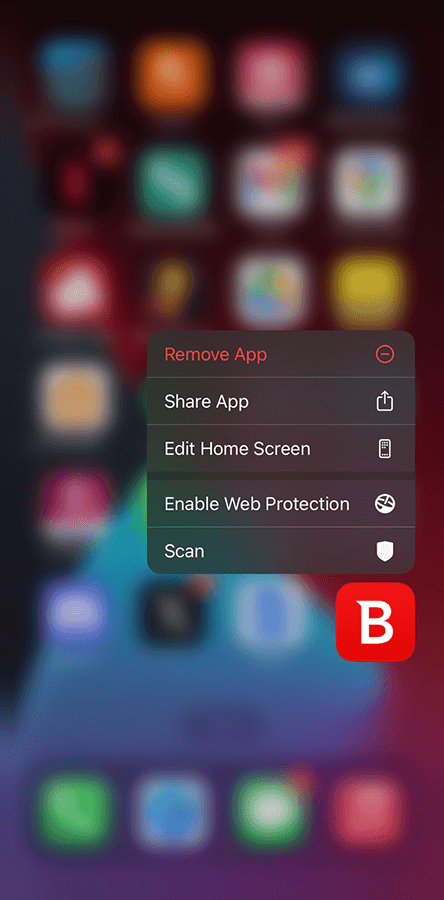
Removing an app from an iPhone requires only a few clicks.
There is some debate regarding whether iPhones need antivirus protection. Viruses aren’t much of a threat to iPhones, but factors like ransomware and phishing could be, so it is worthwhile to protect your device. If you want to pause or stop your antivirus on iOS, we’ll use Bitdefender as an example below to show you how.
- Long-press the antivirus icon on your phone screen.
- Wait for “remove app” to appear.
- Click “remove App.”
Chrome
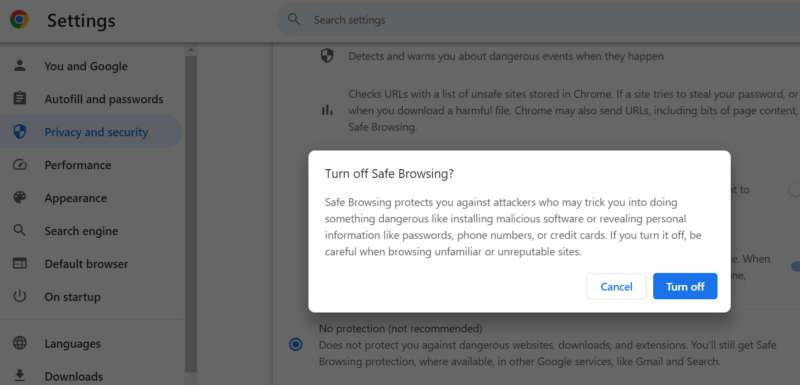
Users can turn off antivirus in Chrome in just a few steps.
Chrome has an easy-to-navigate menu at the top of the page, with several options for customization. Antivirus software can be turned off this way in under a minute.
- Click the three-dot menu in the top-right corner of Chrome.
- Click “settings.”
- Click “privacy and security.”
- Select “no protection (not recommended).”
Why Turn Off My Antivirus Software?
Antivirus software helps protect your device from malware, viruses and other threats, but there are certain circumstances in which you may need to permanently or temporarily disable it. For example, some software installation processes require you to turn off your antivirus, as it can interfere with the installation process.
You may also need to disable it when troubleshooting issues with your device. This can help make it clear whether the issue was caused by your antivirus software or something else. Additionally, antivirus software can sometimes slow down the process of streaming or torrenting files. Turning it off temporarily can help speed up downloads.
Final Thoughts
There are several reasons to turn off antivirus software. However, antivirus software is necessary to protect your device against threats. If you are looking for good, free antivirus software, check out our article on the best free antivirus software.
Turning antivirus software on and off is usually a simple process. Do you have any tips or tricks to make it even easier? We hope this article has been helpful. Thanks for reading!
FAQ: How to Turn Off Antivirus Software
-
This varies from system to system and from software to software. Check above for the specific software or system you use and see whether the instructions provided help.
-
First, go to “settings” and select “update and security,” followed by “Windows security.” Next, click “virus and threat protection” and then “manage settings.” Finally, switch off “real-time protection.” Scans will still take place, but no downloaded or installed files will be scanned.
-
Antivirus software helps to keep your system safe. It is fine to turn it off temporarily, but it is not wise to disable it permanently without an alternative in place.
This varies from system to system and from software to software. Check above for the specific software or system you use and see whether the instructions provided help.n”}},{“@type”:”Question”,”name”:”How Do I Turn Off Antivirus in the Windows 10 Control Panel?”,”acceptedAnswer”:{“@type”:”Answer”,”text”:”
First, go to u201csettingsu201d and select u201cupdate and security,u201d followed by u201cWindows security.u201d Next, click u201cvirus and threat protectionu201d and then u201cmanage settings.u201d Finally, switch off u201creal-time protection.u201d Scans will still take place, but no downloaded or installed files will be scanned.n”}},{“@type”:”Question”,”name”:”Is It Safe to Turn Off Windows Antivirus? “,”acceptedAnswer”:{“@type”:”Answer”,”text”:”
Antivirus software helps to keep your system safe. It is fine to turn it off temporarily, but it is not wise to disable it permanently without an alternative in place.n”}}]}]]>
Let us know if you liked the post. That’s the only way we can improve.
Also interesting
Last published on Cloudwards:
Originally a software engineer, Aleksander decided to leave the office lifestyle behind to live as a digital nomad. He now spends his time writing about technology and tourism, which allows him the freedom to call many different places home. When he’s not writing or editing, he likes to read fantasy/sci-fi, listen to podcasts about history and politics and travel.
Last published on Cloudwards:

